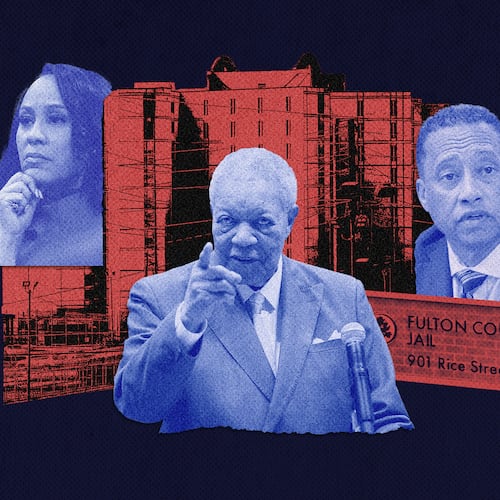As a child in the United States, justice often depends on where you live, the color of your skin, which police officer arrests you, or which judge, prosecutor or probation officer happens to be involved in your case.
Juvenile courts across the country processed 750,000 cases in 2018. About 200,000 of these cases involved detention — removing a young person from home and locking them away, according to data from the federal Office of Juvenile Justice and Delinquency Prevention.
In one place, a crime like simple assault or gun possession could lead to a customized rehabilitation program with help from mentors. It also could mean confinement in a group home, where kids wear their own clothes and counselors call them by their first names. Or it could mean time in a barbed wire-rimmed “prison for kids,” part of a system rife with rioting, suicide, and sexual assault.
“We call it justice by geography,” said Elizabeth Cauffman, a developmental psychologist at University of California, Irvine. “Where you live determines how you’re treated as a juvenile.”
Some young offenders, including Zyion Houston-Sconiers of Tacoma, Wash., skip the youth facilities and are sentenced as adults, subjecting them to the same prosecution and prisons as older and more violent criminals.
Others, like Will Lewis from Riverdale, Ga., are steered by police, probation officers, defense attorneys, prosecutors, judges, or others toward the system’s “off-ramps” — diversion or second chance programs designed to give them skills and improve their futures.
Today, Houston-Sconiers is inmate #368944 at the Monroe Correctional Complex in a Seattle suburb.
Lewis juggles raising his infant daughter, Carmen, working with the Brighter Future initiative at United Way of Greater Atlanta, while he looks for his dream job as an IT specialist in the aviation industry.
According to Office of Juvenile Justice and Delinquency Prevention data from 2018, nearly 40% of Black juveniles charged with weapons offenses had their cases adjudicated — deemed responsible for their actions, most likely by a juvenile judge — and about 13% were placed in a secure facility away from home. By comparison, nearly 27% of white children facing the same charges were adjudicated and about 5% were placed in a facility.
Although they represent 14% of the country’s children age 18 or younger, Black kids account for 66% of the U.S.'s youth robbery offenses.
Lewis and Houston-Sconiers are Black, 25 years old, and both have a propensity for data and numbers. Lewis recently graduated from Middle Georgia State University with a master’s degree in cybersecurity; Houston-Sconiers earns money from day-trading stocks with the help of his wife while behind bars.
They both grew up poor, joined gangs to find the camaraderie and love their fractured families couldn’t provide — and both admit they made a mistake. As teenagers, both committed robbery and had their cases tried in adult court.
Backed by friends, Houston-Sconiers threatened kids in his neighborhood with a gun to hand over their Halloween candy. Lewis and some friends attacked a group of boys in a back alley, emptying their pockets in the process.
“What we call it in the streets is respect … when all it is love,” Lewis said, referring to what the gang provided him. Growing up in poverty, he said, “your family is in survival mode constantly, so there’s no room for, ‘Hey, I love you.’”
Following their arrests, Lewis and Houston-Sconiers had life-changing interactions. Lewis for the better, in an innovative second-chance program. Houston-Sconiers, for the worse, after he was sentenced to 31 years in prison.
“I knew deep down in my heart that I wanted better,” Lewis said. " I just didn’t know how to get it."
According to researchers and advocates, detention hurts the development of young people, making them less likely to graduate from high school or find a steady job, and more likely to end up in prison as adults.
“(We) think that yelling at them and shaming them and blaming them and incarcerating them and threatening them is going to get a result,” said Adam Foss, a former Suffolk County assistant district attorney in Boston. “But really all that is doing is further entrenching their trauma and making them more violent people.”
Houston-Sconiers was 17 at the time of his crime. In prison, he doesn’t get much sleep. He adheres to his “program”: a strict weekday routine starting at 6:30 a.m. He reads the Wall Street Journal or Forbes magazine, skips prison breakfasts of bran bars in favor of trading stocks, gives his wife a call to “make sure she made it to work.”
“You have to work through the brick walls you run into, you gotta find a way around them,” he said.
Unraveling the system
Most advocates agree that youth incarceration in prison-like facilities should be reserved for rare cases and replaced by rehabilitative programs. Elizabeth Cauffman oversees the Crossroads Study, a study based at University of California, Irvine, where her team studied how the system handles “tipping point” offenses — burglary, simple assault and other medium-level offenses.
What they’ve found, she said, is that for juveniles who commit these crimes, the likelihood of being locked up is “basically 50-50. Some of those kids get probation or get some sort of diversion and some of those kids get locked up.”
“The more punitive, the more harsh, the more the severe the sanction, the worse the outcome for the kid,” she said. “If you really want to improve public safety, if you really want to reduce criminal offending, getting tough is not the solution.”
On Oct. 31, 2012, in Tacoma, Houston-Sconiers and four other boys, armed with a small silver revolver, approached groups of trick-or-treaters and other individuals, and stole 96 pieces of candy, a pumpkin candy bag, a red devil mask and a phone.
Houston-Sconiers was tried as an adult, convicted of robbery, and given a sentence that would have kept him locked up until he was nearly 50. Jeannie Darneille, who was elected to Washington’s state Senate just one week after Houston-Sconiers' arrest, said she was flabbergasted.
Since 2012, she has led the effort to undo the legislation involved in his case and enact reforms for the juvenile justice system in Washington. She proposed new laws, including one that led to Houston-Sconiers' release after five years served. But shortly after, he reoffended.
According to data from the Office of Juvenile Justice and Delinquency Prevention, nearly 2.5 million kids were arrested in 1999 and more than 100,000 were detained on any one day in a juvenile facility. In 2018, the number of kids arrested fell to nearly 730,000 and the number of detained kids on a given day dropped to just more than 37,500.
Credit: GRACIE BONDS STAPLES/gstaples@AJ
Credit: GRACIE BONDS STAPLES/gstaples@AJ
Some courts offer alternatives. Judge Steven Teske, the juvenile judge who oversaw Lewis' case in Georgia’s Clayton County, took note of the model airplanes probation officers saw in the Lewis home and the decent grades on his report cards. He saw a future Lewis didn’t see for himself.
Teske enrolled Lewis in “Second Chance Court,” a program that offers high-risk felony offenders an alternative to detention. If Lewis and others in the program comply with the court’s requirements, which include wearing a GPS tracker for six months and cognitive behavioral therapy, they can avoid detention. Lewis went on to earn a bachelor’s degree in aviation science and management.
According to Teske, 65% of juveniles who are sent to Georgia’s youth prisons reoffend upon release. But only 17% in Teske’s second chance program reoffend.
“I’m just trying to get them to adulthood without killing somebody else or themselves, creating the opportunity to do what the science informs me that most of them will do, and that is age out of delinquency,” Teske said.
The mind of a child
Houston-Sconiers said his mother abused him physically for more than a decade before child protective workers placed him in foster care. When he was 12, he began running away from his foster homes and committing petty crimes, like vandalizing city buses. From age 12 to 17, he cycled between foster homes and juvenile detention centers.
“I think I’ve only spent, like, two of my birthdays since the age of 12 … actually out,” Houston-Sconiers said. “The rest of them I’ve been incarcerated for.”
Eventually, he landed with a family in University Place, Wash.
“I was doing great, I really was. I was going to school every day, I was making my allowance money,” he said. “This was the first place I felt the love.”
But Houston-Sconiers said child protective workers involuntarily removed him from the home and returned him to Hilltop, where he found camaraderie with the Hilltop Crips, a gang that rose to infamy during the country’s crack epidemic and took to the streets.
Teske said he often consults with jurisdictions across the country that “divert very few kids” and “can’t figure out why their recidivist rate is high.”
“Most kids age out of their delinquency and you’re not giving them a chance to do it, for God’s sakes,” he said.
Adam Foss, a former prosecutor, said he graduated from law school “without hearing the word trauma.” Throughout Foss' career, he opposed locking up young people.
Delinquency “is very normative, boneheaded behavior,” said Foss, who runs Prosecutor Impact, a not-for-profit dedicated to educating prosecutors. “Then at some point time you just stop. And it’s not because you’ve learned your lesson. It’s because you’ve literally grown; you’re now an adult.”
He said it is inappropriate for juveniles to be treated as adults.
“Some prosecutors disagree and think that there are situations where it is not only appropriate but preferred," he said in an email. "According to physicians, psychologists, scientists, criminologists, and impacted communities, those prosecutors are wrong, and they are actively harming the community that they should be serving.”
Katherine Sypher and Anthony J. Wallace are Donald W. Reynolds Foundation fellows.
This story was part of “Kids Imprisoned,” an investigation into juvenile justice in America. “Kids Imprisoned” was the 2020 project of the Carnegie-Knight News21 program, a multimedia reporting project produced by the country’s top journalism students and graduates.
Keep Reading
The Latest
Featured






